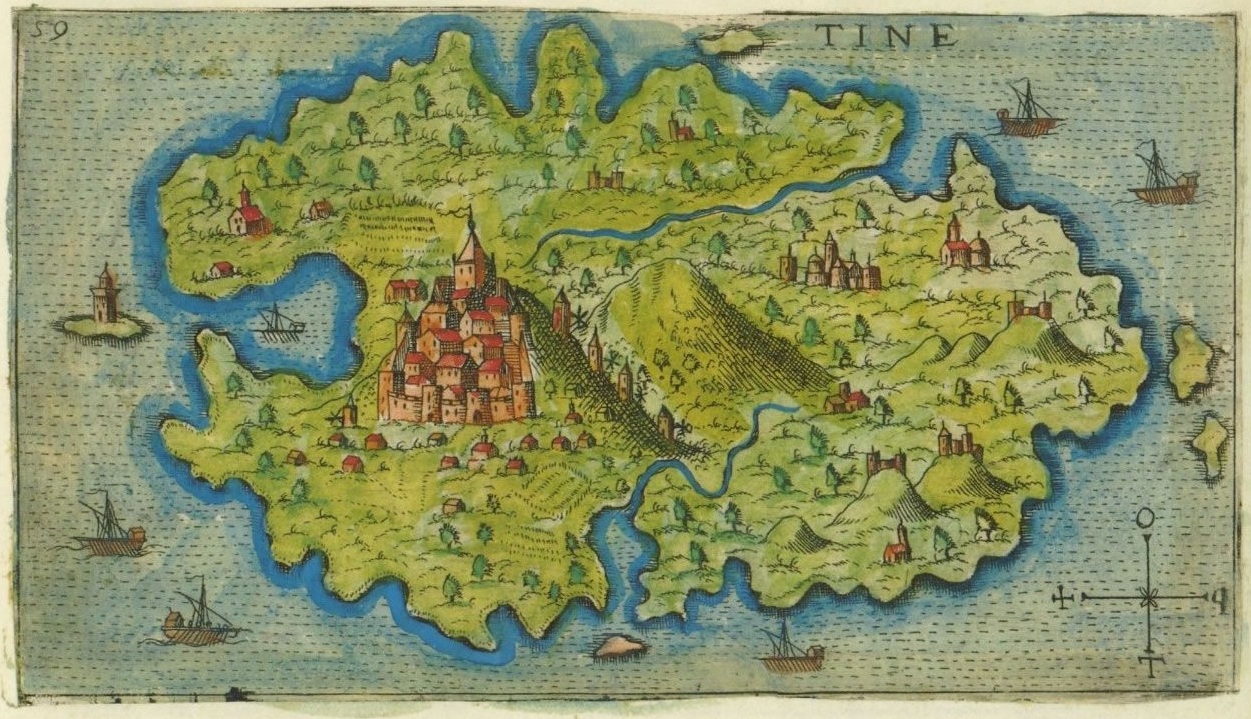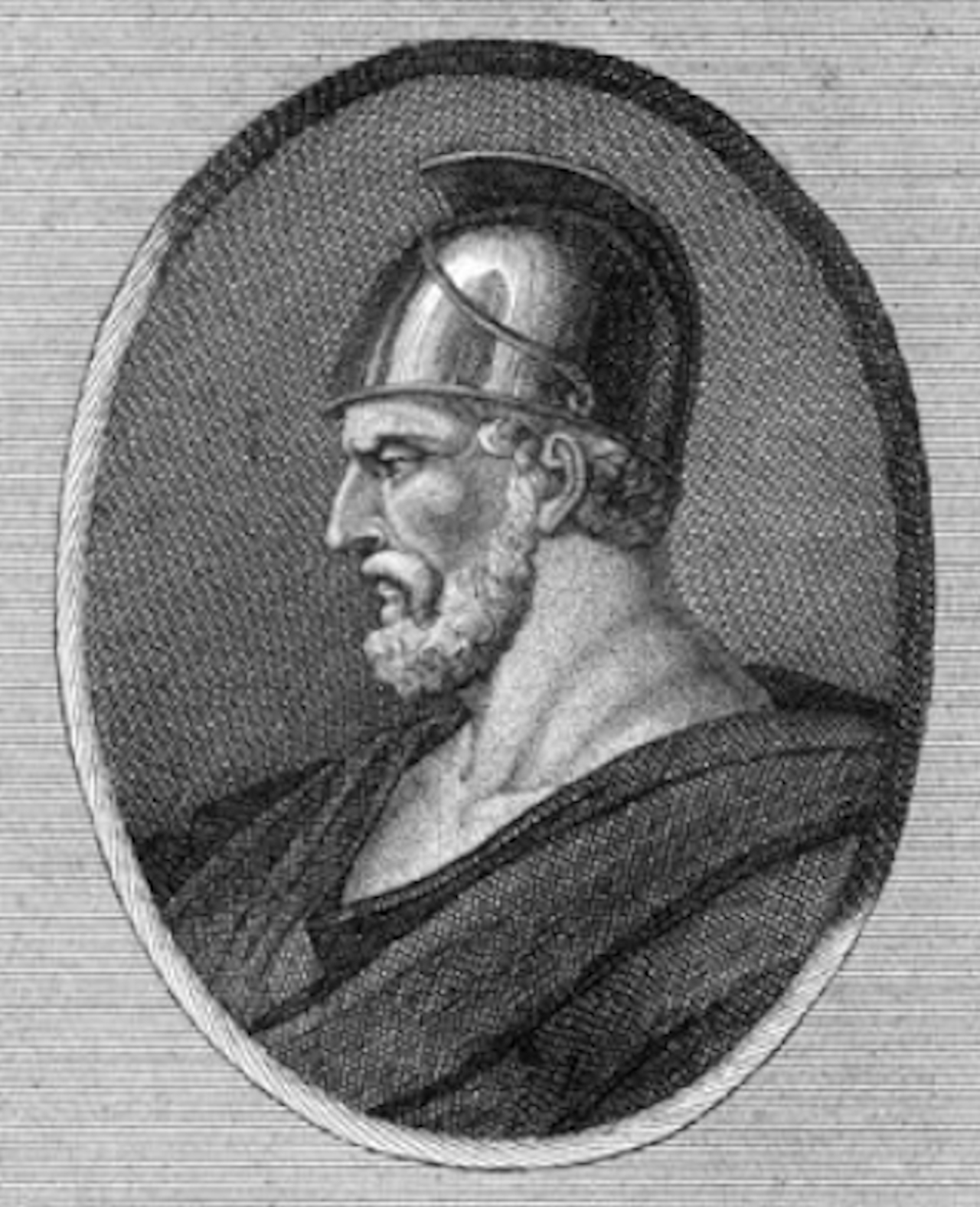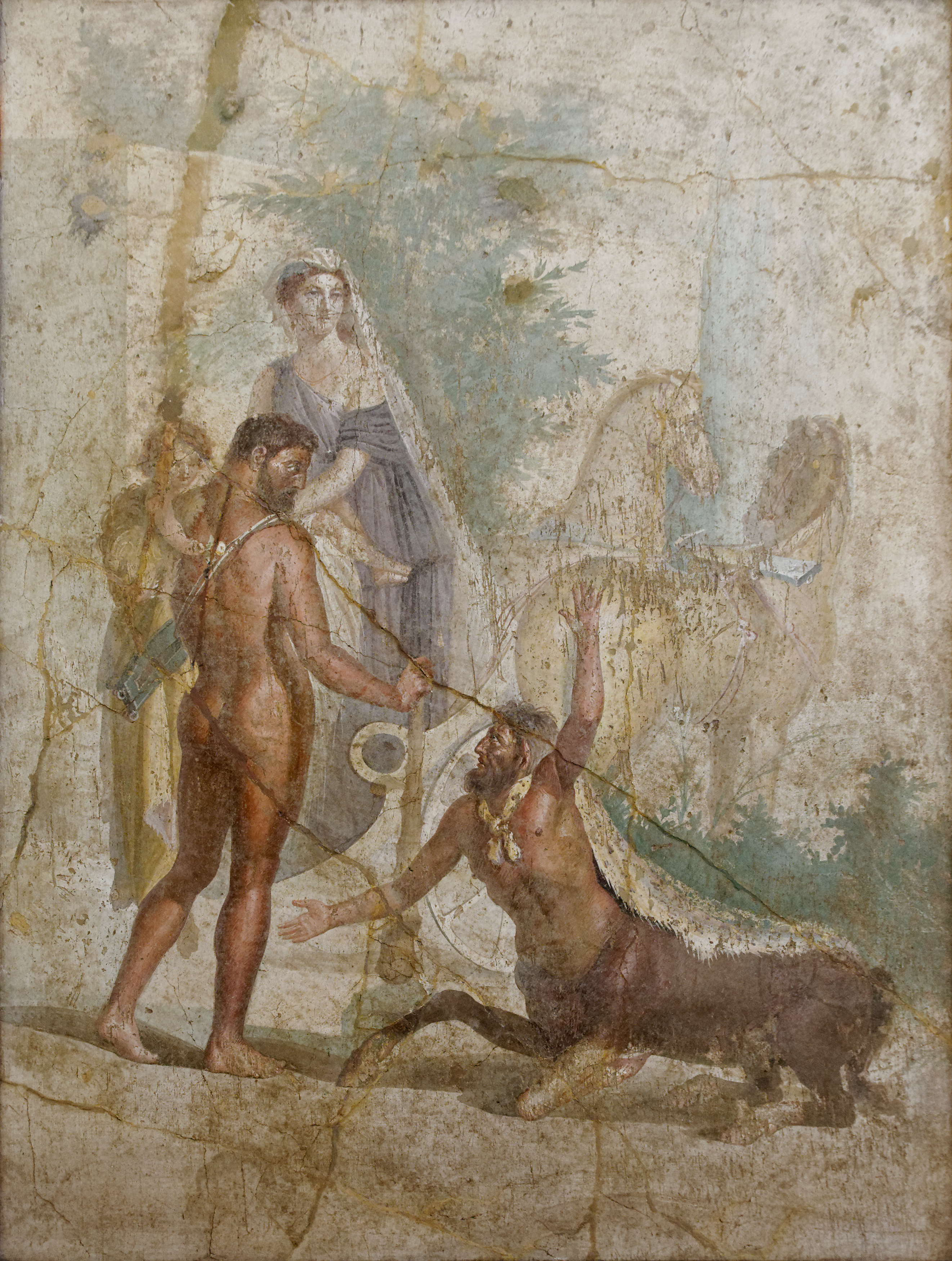|
Tenos
Tinos ( ) is a Greek island situated in the Aegean Sea. It forms part of the Cyclades archipelago. The closest islands are Andros, Delos, and Mykonos. It has a land area of and a 2021 census population of 8,934 inhabitants. Tinos is famous amongst Greeks for the Church of Panagia Evangelistria, for the island's 80 or so windmills, for about 1,000 artistic dovecotes, for 50 active villages and for the Venetian fortifications on the mountain Exomvourgo. On Tinos, both Greek Orthodox and Catholic populations co-exist, and the island is also well known for its sculptors and painters, such as Nikolaos Gysis, Yannoulis Chalepas and Nikiforos Lytras. The island is located near the geographical center of the Cyclades islands complex, and because of the Panagia Evangelistria church, with the reputedly miraculous icon of Virgin Mary that it holds, Tinos is also the center of a yearly pilgrimage that takes place on the date of the Dormition of the Virgin Mary (15 August, ). Many ... [...More Info...] [...Related Items...] OR: [Wikipedia] [Google] [Baidu] |
Our Lady Of Tinos
Our Lady of Tinos (, '' Panagía Evangelístria tēs Tēnou'', "The All-Holy Bringer of Good News", and , ''Megalócharē tēs Tēnou'', "She of Great Grace") is the major Marian shrine in Greece. It is located in the town of Tinos on the island of Tinos. The complex is built around a miraculous icon which according to tradition was found after the Virgin appeared to the nun Pelagia and revealed to her the place where the icon was buried. The icon is widely believed to be the source of numerous miracles. It is by now almost completely encased in silver, gold, and jewels, and is commonly referred to as the "''Megalócharē''" (" he ofGreat Grace") or simply the "''Chárē Tēs''" ("Her Grace"). By extension the church is often called the same, and is considered a protectress of seafarers and healer of the infirm. The icon was found on the very first days after the creation of the modern Greek State, henceforth Our Lady of Tinos was declared the patron saint of ... [...More Info...] [...Related Items...] OR: [Wikipedia] [Google] [Baidu] |
Nikiforos Lytras
Nikiforos Lytras (; 1832 – 13 June 1904) was a Greek painter. He was born in Tinos and trained in Athens at the School of Arts. In 1860, he won a scholarship to Royal Academy of Fine Arts of Munich. After completing these studies, he became a professor at the School of Arts in 1866, a position he held for the rest of his life. He remained faithful to the precepts and principles of the Munich School, while paying greatest attention both to ethnographic themes and portraiture. His most famous portrait was of the royal couple, Otto and Amalia, and his most well-known landscape a depiction of the region of Lavrio. Biography Nikiforos Lytras was the son of a popular marble sculptor. In 1850, at the age of eighteen years he went to Athens to study in the School of Arts. He studied painting with Ludwig Thiersch and Raffaelo Ceccoli (c.1800-after 1860). After graduating in 1856, he began teaching an elementary course in writing. In 1860 with a Greek government's scholarship he ... [...More Info...] [...Related Items...] OR: [Wikipedia] [Google] [Baidu] |
Marcus Antonius
Marcus Antonius (14 January 1 August 30 BC), commonly known in English as Mark Antony, was a Roman politician and general who played a critical role in the transformation of the Roman Republic from a constitutional republic into the autocratic Roman Empire. Antony was a relative and supporter of Julius Caesar, and he served as one of his generals during the conquest of Gaul and Caesar's civil war. Antony was appointed administrator of Italy while Caesar eliminated political opponents in Greece, North Africa, and Spain. After Caesar's assassination in 44 BC, Antony joined forces with Lepidus, another of Caesar's generals, and Octavian, Caesar's great-nephew and adopted son, forming a three-man dictatorship known to historians as the Second Triumvirate. The Triumvirs defeated Caesar's killers, the ''Liberatores'', at the Battle of Philippi in 42 BC, and divided the government of the Republic among themselves. Antony was assigned Rome's eastern provinces, including t ... [...More Info...] [...Related Items...] OR: [Wikipedia] [Google] [Baidu] |
Alexander Of Pherae
Alexander () was Tyrant or Despot of Pherae in Thessaly, ruling from 369 to 356 BC. Following the assassination of Jason, the tyrant of Pherae and Tagus of Thessaly, in 370 BC, his brother Polyphron ruled for a year, but he was then poisoned by Alexander who assumed power himself. Alexander governed tyrannically and was constantly seeking to control Thessaly and the kingdom of Macedonia. He also engaged in piratical raids on Attica. Alexander was murdered by Tisiphonus, Lycophron and Peitholaus, the brothers of his wife, Thebe, as it was said that she lived in fear of her husband and hated Alexander's cruel and brutal character. Reign The accounts of how Alexander came to power vary somewhat in minor points. Diodorus Siculus tells us that upon the assassination of the tyrant Jason of Pherae, in 370 BC, his brother Polydorus ruled for a year, but he was then poisoned by Alexander, another brother.Diodorus Siculus, xv. 60-61 However, according to Xenophon, Polydorus was murde ... [...More Info...] [...Related Items...] OR: [Wikipedia] [Google] [Baidu] |
Delian League
The Delian League was a confederacy of Polis, Greek city-states, numbering between 150 and 330, founded in 478 BC under the leadership (hegemony) of Classical Athens, Athens, whose purpose was to continue fighting the Achaemenid Empire, Persian Empire after the Greek victory in the Battle of Plataea at the end of the Second Persian invasion of Greece. The League functioned as a dual –offensive and defensive– alliance (''Symmachia (alliance), symmachia'') of autonomous states, similar to its rival association, the Peloponnesian League. The League's modern name derives from its official meeting place, the island of Delos, where congresses were held within the sanctuary of the Temple of Apollo; contemporary authors referred to the organization simply as "the Athenians and their Allies". While Sparta excelled as Greece's greatest power on land, Athens turned to the seas becoming the dominant naval power of the Ancient Greece, Greek world. Following Sparta's withdrawal from the Gr ... [...More Info...] [...Related Items...] OR: [Wikipedia] [Google] [Baidu] |
Battle Of Plataea
The Battle of Plataea was the final land battle during the second Persian invasion of Greece. It took place in 479BC near the city of Plataea in Boeotia, and was fought between an alliance of the Polis, Greek city-states (including Sparta, Classical Athens, Athens, Corinth and Megara), and the Achaemenid Empire of Xerxes I (allied with Greek states including Boeotia, Thessalia, and Macedonia (ancient kingdom), Macedon). At the preceding Battle of Salamis, the allied Greek navy had won an unlikely but decisive victory, preventing the conquest of the Peloponnesus region. Xerxes then retreated with much of his army, leaving his general Mardonius (nephew of Darius I), Mardonius to finish off the Greeks the following year. In the summer of 479BC, the Greeks assembled a huge army and marched out of the Peloponnesus. The Persians retreated to Boeotia and built a fortified camp near Plataea. The Greeks, however, refused to be drawn into the prime terrain for cavalry around the Persian ... [...More Info...] [...Related Items...] OR: [Wikipedia] [Google] [Baidu] |
Pausanias (geographer)
Pausanias ( ; ; ) was a Greek traveler and geographer of the second century AD. He is famous for his '' Description of Greece'' (, ), a lengthy work that describes ancient Greece from his firsthand observations. ''Description of Greece'' provides crucial information for making links between classical literature and modern archaeology, which is providing evidence of the sites and cultural details he mentions although knowledge of their existence may have become lost or relegated to myth or legend. Biography Nothing is known about Pausanias apart from what historians can piece together from his own writing. However, it is probable that he was born into a Greek family and was probably a native of Lydia in Asia Minor. From until his death around 180, Pausanias travelled throughout the mainland of Greece, writing about various monuments, sacred spaces, and significant geographical sites along the way. In writing his '' Description of Greece'', Pausanias sought to put together ... [...More Info...] [...Related Items...] OR: [Wikipedia] [Google] [Baidu] |
Delphi
Delphi (; ), in legend previously called Pytho (Πυθώ), was an ancient sacred precinct and the seat of Pythia, the major oracle who was consulted about important decisions throughout the ancient Classical antiquity, classical world. The Ancient Greece, ancient Greeks considered the centre of the world to be in Delphi, marked by the stone monument known as the Omphalos of Delphi (navel). According to the Suda, Delphi took its name from the Delphyne, the she-serpent (''Drakaina (mythology), drakaina'') who lived there and was killed by the god Apollo (in other accounts the serpent was the male serpent (''drakon'') Python (mythology), Python). The sacred precinct occupies a delineated region on the south-western slope of Mount Parnassus. It is now an extensive archaeological site, and since 1938 a part of Mount Parnassus, Parnassos National Park. The precinct is recognized by UNESCO as a World Heritage Site in having had a great influence in the ancient world, as evidenced ... [...More Info...] [...Related Items...] OR: [Wikipedia] [Google] [Baidu] |
Battle Of Salamis
The Battle of Salamis ( ) was a naval battle fought in 480 BC, between an alliance of Greek city-states under Themistocles, and the Achaemenid Empire under King Xerxes. It resulted in a victory for the outnumbered Greeks. The battle was fought in the straits between the mainland and Salamis, an island in the Saronic Gulf near Athens, and marked the high point of the second Persian invasion of Greece. It was arguably the largest naval battle of the ancient world, and marked a turning point in the invasion. To block the Persian advance, a small force of Greeks blocked the pass of Thermopylae, while an Athenian-dominated allied navy engaged the Persian fleet in the nearby straits of Artemisium. In the resulting Battle of Thermopylae, the rearguard of the Greek force was annihilated, while in the Battle of Artemisium the Greeks suffered heavy losses and retreated after the loss at Thermopylae. This allowed the Persians to conquer Phocis, Boeotia, Attica and Euboea. The allies ... [...More Info...] [...Related Items...] OR: [Wikipedia] [Google] [Baidu] |
Trireme
A trireme ( ; ; cf. ) was an ancient navies and vessels, ancient vessel and a type of galley that was used by the ancient maritime civilizations of the Mediterranean Sea, especially the Phoenicians, ancient Greece, ancient Greeks and ancient Rome, Romans. The trireme derives its name from its three rows of oars, manned with one man per oar. The early trireme was a development of the penteconter (ship), penteconter, an ancient warship with a single row of 25 oars on each side (i.e., a single-banked boat), and of the bireme (, ), a warship with two banks of oars, of Phoenician origin. The word ''dieres'' does not appear until the Roman period. According to Morrison and Williams, "It must be assumed the term pentekontor covered the two-level type". As a ship, it was fast and agile and was the dominant warship in the Mediterranean from the 7th to the 4th centuries BC, after which it was largely superseded by the larger quadriremes and quinqueremes. Triremes played a vital role in t ... [...More Info...] [...Related Items...] OR: [Wikipedia] [Google] [Baidu] |
Xerxes I
Xerxes I ( – August 465 BC), commonly known as Xerxes the Great, was a List of monarchs of Persia, Persian ruler who served as the fourth King of Kings of the Achaemenid Empire, reigning from 486 BC until his assassination in 465 BC. He was the son of Darius the Great and Atossa, a daughter of Cyrus the Great. In Western history, Xerxes is best known for his Second Persian invasion of Greece, invasion of Greece in 480 BC, which ended in Persian defeat. Xerxes was designated successor by Darius over his elder brother Artobazan and inherited a large, multi-ethnic empire upon his father's death. He consolidated his power by crushing revolts in Twenty-seventh Dynasty of Egypt, Egypt and Babylonian revolts (484 BC), Babylon, and renewed his father's campaign to subjugate Ancient Greece, Greece and punish Classical Athens, Athens and its allies for their interference in the Ionian Revolt. In 480 BC, Xerxes personally led a large army and crossed the Dardanelles, Hellespont into Eu ... [...More Info...] [...Related Items...] OR: [Wikipedia] [Google] [Baidu] |
Heracles
Heracles ( ; ), born Alcaeus (, ''Alkaios'') or Alcides (, ''Alkeidēs''), was a Divinity, divine hero in Greek mythology, the son of ZeusApollodorus1.9.16/ref> and Alcmene, and the foster son of Amphitryon.By his adoptive descent through Amphitryon, Heracles receives the epithet Alcides, as "of the line of Alcaeus (mythology), Alcaeus", father of Amphitryon. Amphitryon's own, mortal son was Iphicles. He was a descendant and half-brother (as they are both sired by the god Zeus) of Perseus. He was the greatest of the Greek heroes, the ancestor of royal clans who claimed to be Heracleidae (), and a champion of the Twelve Olympians, Olympian order against chthonic monsters. In Roman mythology, Rome and the modernity, modern western world, West, he is known as Hercules, with whom the later Roman emperors, in particular Commodus and Maximian, often identified themselves. Details of his cult (religion), cult were adapted to Rome as well. Origin Many popular stories were told ... [...More Info...] [...Related Items...] OR: [Wikipedia] [Google] [Baidu] |






